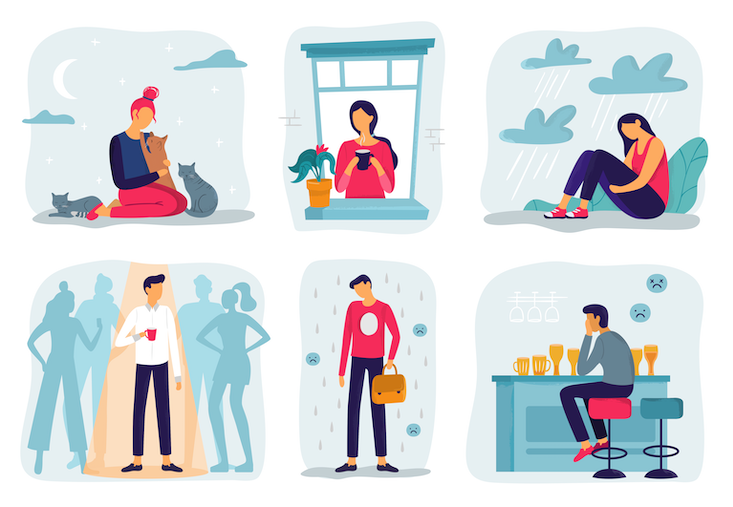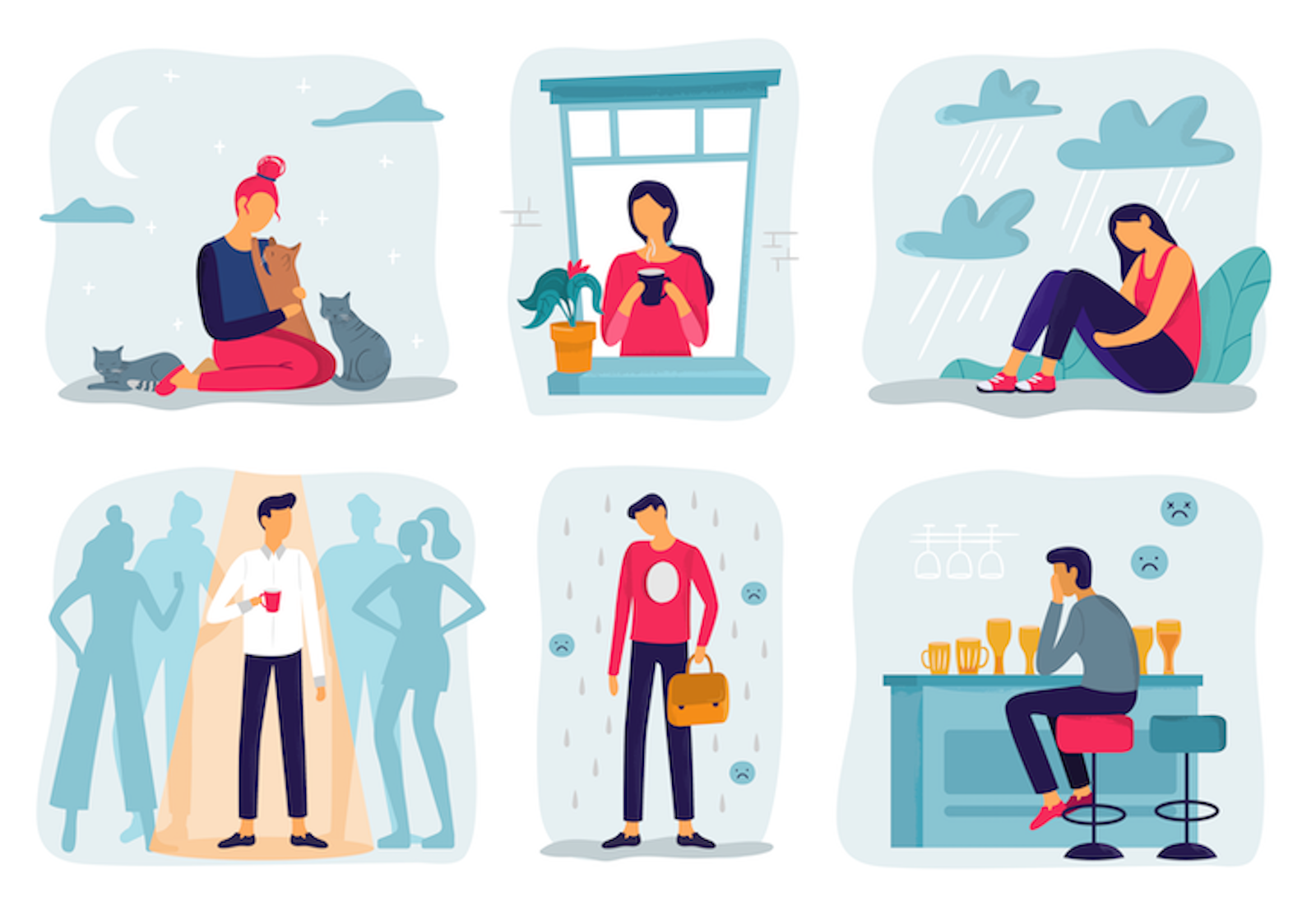
Amid all the calls in nearly every country for social distancing, the most powerful tool we have to slow the spread of the novel coronavirus, one important fact gets lost: We are fundamentally social beings, and social distancing can carry a heavy psychological price tag. This is particularly true for people who live on their own, but we can all struggle with the emotional impact of isolation and its first cousin, loneliness.
Although there’s been no time to study the effects of social distancing related specifically to the novel coronavirus, we know a great deal about the impact of social isolation on mental and physical health. It’s often experienced as highly stressful, and the stress can become toxic. Isolation, particularly when it causes loneliness, increases the risk of anxiety and depression. Social isolation has the equivalent adverse impact on physical health to smoking 15 cigarettes a day. It’s a greater threat to health than obesity, and is linked to an increased risk of a wide variety of health problems. In a study highly relevant to our current situation, students who reported higher levels of loneliness responded less powerfully to flu vaccinations.
The growing recognition that social distancing carries psychological and physical health risks has led to a growing call to change the term to “physical distancing,” a recognition that what we need is greater physical distance between people, not greater social distance. Yes, physical distance certainly means a reduction in social contact, and no amount of rebranding the term will can change that. But the idea is still a good one: Let’s focus on reducing physical contact, while maintaining—to the extent possible—the social connections that help us thrive and stay healthy. Let’s protect ourselves psychologically as well as physically, while doing everything possible to slow the spread of the virus—to “flatten the curve” of its impact.
Just remember: We keep ourselves virus-free not just to protect ourselves, but to slow the spread of the virus among everyone.
This shift towards thinking in terms of physical rather than social distancing can be seen in the titles of some very useful articles, like “Physical, Not Social Distancing: Staying Connected in the Coronavirus Age”; “How to Socially Distance and Stay Sane”; “Corona and the Isolation Paradox”; and “Staying Happy While Social Distancing.”
Once we distinguish between physical and social distancing, we can refocus on the power of staying socially connected while maintaining a safe physical distance. We can easily get creative in finding ways of building in social time for ourselves, and for those we care about who might be feeling isolated. None of it is rocket science, but small steps can lead to big effects.
- If you live in a place where you’re allowed to go outside, invite friends for walks, meet up for a run, just spend time together. It doesn’t matter where you walk: Wander through a park, stroll along city streets, jog on a country road. Just remember to keep about two meters (six feet) between each other, avoid shaking hands, all the usual precautions.
- Video calls are wonderful, and phone calls, too. If you have elderly relatives or friends who have smartphones or computers but don’t know how to use them for video calls, this is a great time to introduce them to Skype, WhatsApp, Facetime, etc. I live in Amsterdam, and just got off of a video chat with my 80-year-old mother in New York, who just learned that she has FaceTime on her iPad. We chatted for about an hour, and it was almost like we were sitting together in person.
- If you are working from home, create an online working group. Meet for a video lunch: Just turn on the camera and microphone and eat “together.”
- Text messages are quick and easy ways to stay connected, even to say, “I’m thinking of you.” My research team in Lebanon is on pause due to the country’s lockdown, but we chat throughout the day using WhatsApp, and the contact really makes a difference.
Experts are mixed on just how much actual social contact is safe. See this excellent article from The Atlantic: “The Do’s and Don’ts of Social Distancing,” an interview with three public health experts. Carolyn Cannuscio from the Center for Public Health Initiatives at the University of Pennsylvania, takes the view that neighbors or households who agree to limit outside contact can socialize with each other. And while the Center for Disease Control and Prevention (CDC) is still recommending that social gatherings be limited to fewer than 10 people, the CDC guidelines seem out of sync with other more stringent calls, particularly given that we can carry the virus yet be symptom-free for several days (and thus unknowingly transmit it to others). Unless you live in an area under full lockdown, where leaving home is banned, you’ll need to make your own decisions about how much in-person contact you feel comfortable with. Just remember: We keep ourselves virus-free not just to protect ourselves, but to slow the spread of the virus among everyone, especially those most vulnerable who might require intensive medical care.
Finally, there’s no doubt that physical isolation does reduce social contact, even with all of the steps we can take to stay connected socially. I’m a rock climber, but the climbing gyms are closed: That’s two evenings a week I am not spending with friends catching up and sharing a fun physical activity. Maybe you do yoga, or dance, or belong to a book club. Some of these things we can do online (online yoga classes are easy to find, and book clubs can meet via video conferencing). But the reality is that we also need to take steps to manage the anxiety that can accompany a drop in social contact. This is a great time to develop or increase physical exercise, whether it’s outside, or an in-home yoga practice you do daily. It’s a perfect time to begin or increase a mindfulness practice, to lower stress and find greater calm—and there are lots of online resources and smartphone apps that offer guided meditations and online meditation communities (I use Insight Timer).
One last thought: There’s also value in adopting a perspective of gratitude, despite the hardships created by physical distancing. In refugee communities around the world, in homeless shelters, overcrowded orphanages, and detention centers for asylum-seekers, physical distancing is not even an option. The horrific conditions of everyday life—overcrowded and unsafe housing, poor sanitation, and a lack of even basic medical care—leave people in many places terribly vulnerable to COVID-19 (as well as a host of other diseases). Have a look at this article on the Moira refugee camp in Greece: “Lesbos coronavirus case sparks fear for refugee camp.” Looking at the images of the impoverished and vulnerable community in that camp, we can perhaps take comfort in knowing that our isolation will be temporary, and that we have access to ways of staying socially connected that many people do not. We just need to reach out and make sure we preserve the ties that bind us together.
Kenneth E. Miller is a psychologist and writer and currently a researcher at War Child Holland, where he develops and evaluates mental health interventions for conflict-affected children and families. He is the author of War Torn: Stories of Courage, Love, and Resilience (Larson Publications, 2016) and has worked with refugees and other war-affected populations since 1991, as a researcher, clinician, consultant, and filmmaker.
This post was originally published on Psychology Today, and is reprinted with permission.


























